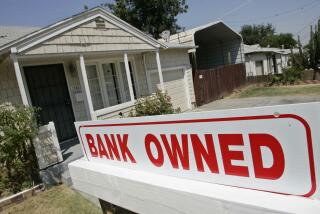Fannie Mae tries to stimulate market for foreclosed homes
If you’re a buyer with little cash or a small-scale investor looking for a deal on a foreclosed house, a little-publicized national lending program could be just what you need this fall.
Here’s what it offers:
• Minimal down payments — 3% for buyers who plan to live in the house, 10% for investors. Most of your down payment can come from documented gifts from relatives or others with no direct connection to the transaction.
• No requirement for an appraisal on the property unless you’re applying for additional money to renovate the house. This is crucial because lowball appraisals can be deal-killers, especially when the house needs cosmetic or other repairs.
• Generous “seller contribution” limits of up to 6% of the price, effectively reducing the cash you’ll need to pay closing costs.
• No requirement for mortgage insurance coverage, despite your high loan-to-value ratio at purchase.
• A minimum credit score of 660 — significantly lower than the 700-plus scores many lenders now demand for conventional loans on favorable terms.
• Maximum loan amounts tied to standard conventional loan limits: $729,750 in the highest cost markets, $625,500 in others, and $417,000 everywhere else.
Who is offering such an unusual package of come-ons like this in an era of stringent underwriting requirements? It’s Fannie Mae, the mortgage investment giant that got into deep trouble when the housing bubble burst and is now bleeding red ink in prodigious quantities under federal conservatorship.
As a result of its past problems, Fannie is saddled with a bulging portfolio of tens of thousands of foreclosed homes. It needs to sell those houses, is willing to finance their transfer to new owners and has come up with a program it calls HomePath to do so. In recent weeks, HomePath loans have been rolled out through mortgage brokers and a network of 50 lenders, so it’s probably available on houses in your area.
The basics on HomePath: The program is restricted to Fannie Mae foreclosure holdings. The full lineup of listings can be viewed state by state at https://www.HomePath.com. Participating real estate brokers are listed on the same site; Fannie Mae will entertain only offers that come through those brokers, not directly from consumers. Most properties are open to bids from owner-occupant buyers and investors, but some designated “First Look” are reserved for bids from owner-occupants during the initial 15 days after listing.
There are two main options with HomePath: mortgage financing to buy the house in its current “as is” condition and “renovation” financing, in which Fannie lends additional amounts needed for what it describes as “light to moderate” fix-ups, such as a roof repair or replacement of a heating, ventilation and air conditioning system.
Standard HomePath listings are all in “move-in condition,” according to Fannie. That is, the company has inspected them, performed at least cosmetic repairs as needed, and determined them to be structurally sound with no code violations and all systems in working order. Listings eligible for renovation financing generally require some work to be funded through add-on amounts to the mortgage that are held in escrow by the lender after closing and disbursed as repairs are completed during the succeeding six months. The maximum rehab amount is $30,000 or 20% of the projected “as completed” value of the renovated house.
Interest rates on both options are slightly higher than prevailing conventional or FHA-insured loan rates. For example, Peter Boutell, co-owner of Santa Cruz Home Finance in Santa Cruz, Calif., says that in mid-August, when 30-year fixed rates on owner-occupied home loans dropped to the 4 3/8% range, applicants making less than 20% down payments were required to pay mortgage insurance premiums that pushed their effective rate to about 4 7/8%. At the same time, HomePath loans with 5% down payments were available at 5 1/8%.
“This is an amazing program” for people looking for a foreclosure at a low price who don’t have big down payment cash, Boutell said. “You cannot buy a fix-up with conventional financing anywhere. Lenders just won’t do them.”
Are there potential downsides to HomePath? Absolutely. Although Fannie Mae says it owns foreclosed houses in a wide variety of neighborhoods, mortgage brokers say they are more likely to be found in lower- to moderate-priced areas that took deeper hits when the housing market unraveled. Buyers looking for pristine properties with zero defects might not find what they want on the HomePath listing board.
But check it out. Fannie’s loan terms will be hard to beat.
kenharney@earthlink.net
Distributed by Washington Post Writers Group.
More to Read
Inside the business of entertainment
The Wide Shot brings you news, analysis and insights on everything from streaming wars to production — and what it all means for the future.
You may occasionally receive promotional content from the Los Angeles Times.








